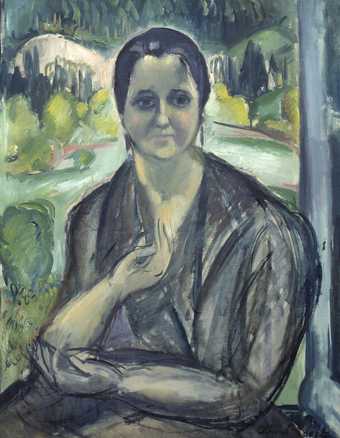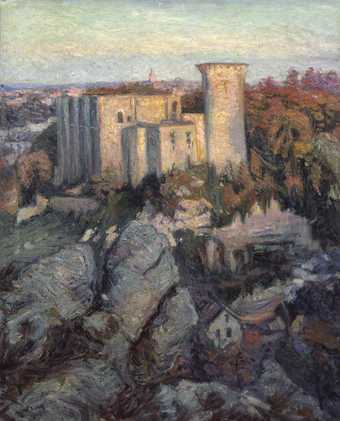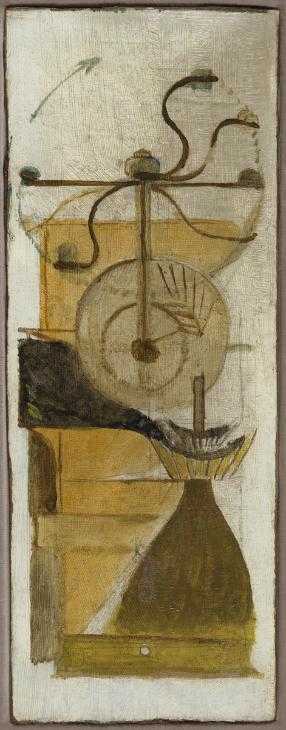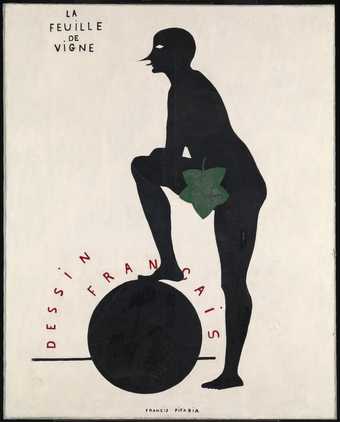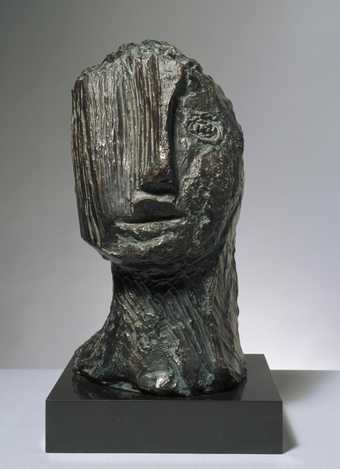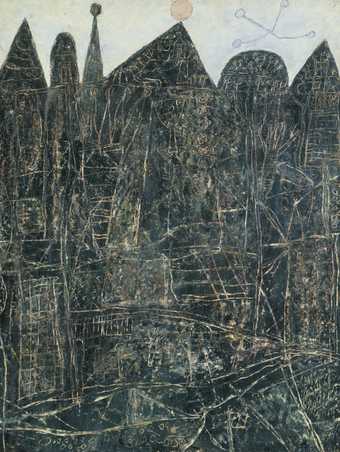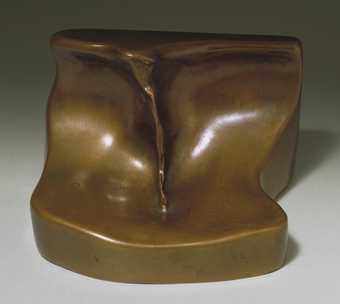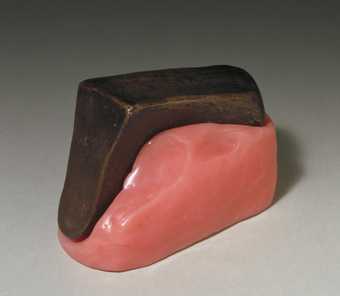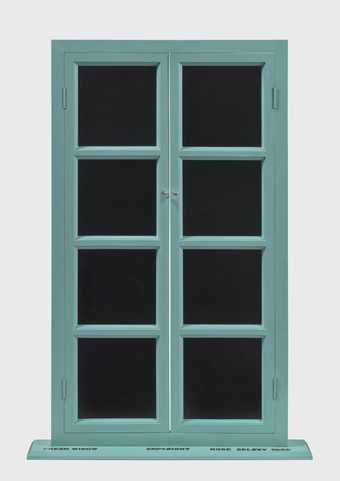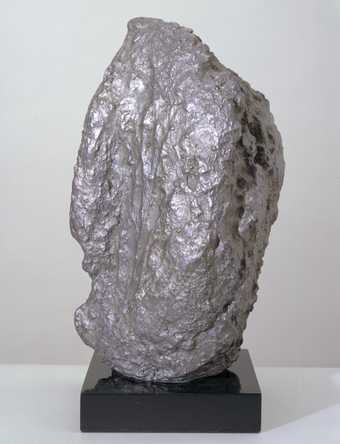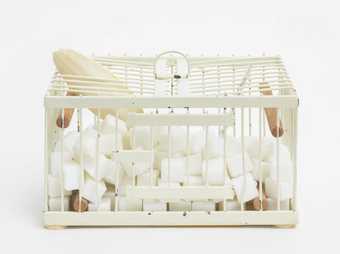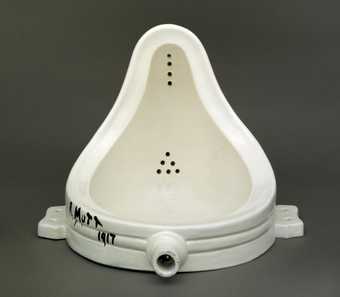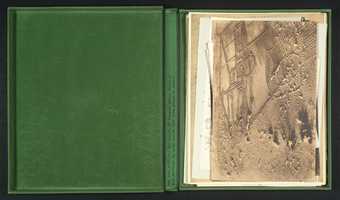Not on display
- Artist
- Marcel Duchamp 1887–1968
- Original title
- La Mariée mise à nu par ses célibataires, même
- Medium
- Oil, lead, dust and varnish on glass
- Dimensions
- Object: 2775 × 1759 mm
- Collection
- Tate
- Acquisition
- Presented by William N. Copley through the American Federation of Arts 1975
- Reference
- T02011
Display caption
In carrying out this reconstruction of The Large Glass, Richard Hamilton deliberately avoided making a copy that acknowledged its fifty years of ageing and deterioration. Instead he set out to make it as it was conceived, accepting that it would similarly change to some extent with the passage of time. Rather than simply working from photographs of the completed work, Hamilton used the notes and drawings of The Green Box to closely follow Duchamp’s original process of creation. By doing this, thirteen years of work were compressed into nearly as many months. As Hamilton recalled after finishing the project, ‘mental effort was exerted only in the direction of detective work, deductions from signs marking a path to be followed – the creative anguish was erased from the trail’. When Duchamp came to London for the opening of his exhibition in 1966, he agreed to sign the reconstruction and the four glass studies produced by Hamilton, inscribing on the back ‘pour copie conforme’ (‘for a faithful replica’).
Gallery label, June 2010
Does this text contain inaccurate information or language that you feel we should improve or change? We would like to hear from you.
Catalogue entry
Marcel Duchamp 1887-1968 and Richard Hamilton born 1922
T02011 La Mariée mise à Nu par ses Célibataires, même
(The Bride Stripped Bare by her Bachelors, Even) 1915-23 (reconstruction by Richard Hamilton 1965-6)
Inscribed by Marcel Duchamp 'Richard Hamilton | pour copie conforme | Marcel Duchamp | 1965' on back, b. centre
Oil, lead wire, lead foil, dust and varnish on glass (in two parts), 107 x 67 (272 x 170), including aluminium frame
Presented by William N. Copley through the American Federation of Arts 1975
Prov:
William N. Copley, New York (commissioned from Richard Hamilton)
Exh:
The Almost Complete Works of Marcel Duchamp, Tate Gallery, June-July 1966 (148, repr.) ; on loan to the Tate Gallery 1966-8 ; Dada, Surrealism and their Heritage, Museum of Modern Art, New York, March-June 1968 (82, original repr.) ; Los Angeles County Museum, July-September 1968 (82, original repr.) ; Art Institute of Chicago, October-December 1968 (82, original repr.) ; on loan to the Tate Gallery from 1974 until presented
Lit:
Marcel Duchamp, La Mariêe mise à Nu par ses Célibataires, même [The Green Box]
(Paris 1934), repr.; André Breton, 'Phare de La Mariée' in Minotaure, II, No.6, 1935, pp.45-9, repr. p.48; Michel Carrouges, Les Machines Célibataires (Paris 1954), pp.27-59; Robert Lebel, Marcel Duchamp
(Paris, London, New York 1959), No.155, pp.13-14, 30-4, 38, 43-4, 46, 48-9, 54-5, 65-75, 80-2, 88-96, 171, repr. fig.43, pl.100a and pl.100b in colour; The Bride Stripped Bare by her Bachelors, Even; a Typographic Version by Richard Hamilton of Marcel Duchamp's Green Box translated by George Heard Hamilton
(London 1960), repr. as frontispiece; Marcel Duchamp, A l'Infinitif [The White Box]
(New York 1967); K.G. Pontus Hultén, The Machine as seen at the end of the Mechanical Age
(New York 1968), pp.77-80, 209, Ulf Linde's replica repr. p.81; Nicholas Calas, 'The Large Glass' in Art in America, LVII, No.4, July-August 1969, pp.34-5, repr. p.34; Arturo Schwarz, The Complete Works of Marcel Duchamp
(London 1969), No.279, pp.79-199, 490, repr. p.490 and pl.97 in colour; Marcel Duchamp, Notes and Projects for the Large Glass
(ed. Arturo Schwartz) (London 1969); Octavio Paz, Marcel Duchamp or The Castle of Purity
(London 1970), this reconstruction repr. in colour as frontispiece; Pierre Cabanne, Dialogues with Marcel Duchamp
(London 1971), pp.18, 36-43, 48-9, 56, 59, 60, 64-7, 75-6, 88; John Golding, Marcel Duchamp: The Bride Stripped Bare by her Bachelors, Even
(London 1973), repr. in black and white, and in colour, details repr. pls.31, 42, 44, 47; Anne d'Harnoncourt and Kynaston McShine (ed.), Marcel Duchamp
(New York 1973), repr. pp.75, 296 and in colour between pp.64 and 65, Ulf Linde's replica repr. p.217; Jean Suquet, Miroir de la Mariée
(Paris 1974); Maurizio Calvesi, Duchamp Invisible: La Costruzione del Simbolo
(Rome 1975), repr. pl.11; Jean Clair, Marcel Duchamp ou le Grand Fictif
(Paris 1975), repr. pl.1, details repr. pls.6, 7, 10, 11; Lawrence D. Steefel, Jr., The Position of Duchamp's 'Glass' in the Development of his Art
(New York and London 1977), pls.30, 44-5, 49, 50, details repr. pls.51-4; exh. catalogue L'Oeuvre de Marcel Duchamp, Centre National d'Art et de Culture Georges Pompidou, Musée National d'Art Moderne, Paris, January-May 1977, Vol.2, pp.107-13, repr. pp.106, 109, 110, 113 and pl.24 in colour, Vol.3, pp.24-41, 60-109, 124-65, repr. pp.125, details repr. pp.28, 134, 137, 141, 145
On the making of this reconstruction:
Richard Hamilton, The Bride Stripped Bare by Her Bachelors Even Again
(Newcastle upon Tyne 1966), np., reconstruction, original, and various photographs of details and work in progress repr.; Andrew Forge, 'In Duchamp's Footsteps' in Studio International, CLXXI, 1966, pp.248-51, details of the unfinished reconstruction repr.; Richard Hamilton, 'Son of the Bride Stripped Bare' in Art and Artists, I, 1966, pp.22-6, reconstruction repr. p.27 in colour, details and photographs of work in progress repr. pp.22-6
Marcel Duchamp began to make 'The Bride Stripped Bare by her Bachelors, Even' (or the 'Large Glass', as it is often known) in New York in September 1915 and continued to work on it at intervals until he set out for a trip to Europe in February 1923, when he pronounced it definitively unfinished. It was bought by Walter C. Arensberg in 1918, but on moving to Los Angeles in 1921 he sold it to Katherine S. Dreier so that it could remain in New York and Duchamp could continue to work on it. In 1926 it was shattered while returning from its first exhibition, the International Exhibition of Modern Art at the Brooklyn Museum. The damage was not discovered until the case was opened several years later and the work was eventually repaired in 1936 by Duchamp himself, who secured the pieces between two sheets of heavier plate glass clamped together by a metal frame. After Katherine Dreier's death in 1952 it passed to the Philadelphia Museum of Art, where it is now.
Although the 'Large Glass' was not begun until 1915, most of Duchamp's work from mid-1912 onwards was concerned with research and studies for various sections of the Glass, including the 'Bride' of 1912, the 'Chocolate Grinder', the 'Glider' and the 'Nine Malic Moulds' of 1913, and the second version of the 'Chocolate Grinder' of 1914. Then in 1934 he published 94 documents relating to it as loose-leaf items in random order in a flat case (The Green Box), including photographs, drawings and manuscript notes covering the period 1911-15 and later. A further 79 notes were published in 1967 (The White Box). Despite their random arrangement, and their elliptical and often enigmatic character, these documents are of crucial importance for the understanding of the Glass as they serve to identify the different elements, and to throw light on their interrelationship and on the meaning of the whole. Any attempt to summarise this commentary in a few words would be grossly misleading, but what can be said is that the Glass is divided horizontally into two parts, with the female section (the Bride's Domain) at the top and the male section (the Bachelor Apparatus) below, and that it constitutes a diagram of an ironic love-making machine of extraordinary complexity in which the male and female machines communicate only by means of two circulatory systems, and without any point of contact. In addition some have seen in it references to alchemy, the Tarot cards, Christian symbolism, and also a preoccupation with perspective and the fourth dimension. A list of some of the many books and articles relating to it is given in the first part of the bibliography.
The idea of making this reconstruction came from Richard Hamilton, who had been asked by the Arts Council to organise a major retrospective exhibition of Marcel Duchamp's work to be held at the Tate Gallery in June-July 1966. As it was impossible to borrow the original because of its fragility and as it seemed unsatisfactory to make do with photographs, Hamilton decided that he would like to make a full-scale reconstruction if the costs could be met. There was already the precedent of the copy made by Ulf Linde in 1961 for the Rörelse i Konsten (Art in Motion) exhibition at the Moderna Museet in Stockholm. The Tate Gallery Trustees felt that they could not make payments towards the cost of a work which did not yet exist, so he went to New York and contacted William N. Copley, who was a friend of Duchamp and himself. He said that he would like to have it and agreed to pay a sum to cover the cost of the materials and, at Hamilton's suggestion, to give Duchamp an equal amount as a fee.
Richard Hamilton had already been an admirer and friend of Duchamp's for some years. His interest in Duchamp went back to 1947 or 1948 when he saw the Green Box at Roland Penrose's, then in 1956 he wrote to him and suggested making a typographical version of it. They met for the first time about 1958. Duchamp put him in touch with the American art historian George Heard Hamilton, who was interested in the same project; and the book, translated by George Heard Hamilton and with typographical lay-out by Richard Hamilton, was published in 1960 with a dedication to William N. Copley and his wife. Then in 1963 Richard Hamilton gave a lecture on the 'Large Glass' at the Pasadena Museum of Art during the Duchamp exhibition there.
Ulf Linde's version was made from photographs of the original, which Linde himself had never seen, and is inaccurate in certain respects. Prompted by a full size photographic copy on film for a BBC programme on Duchamp, Hamilton had, that same year, thought about the possibility of making a replica. However he decided in 1965 that he would make a reconstruction not by working from photographs but by using the detailed documentation in the Green Box to retrace the various stages which led up to the production of the original work. It was made in the Fine Art Department of the University of Newcastle upon Tyne, where he was teaching at the time.
The first step was to make a full-size perspective drawing from the given dimensions in the plan and elevation and other Green Box
notes for the lower part of the Glass, in the hope of producing a drawing similar to the one which once existed on the plaster wall of Duchamp's studio in Paris, but which has since been destroyed. To produce this he found it necessary to do dozens of other perspective studies and to work with threads, using the vanishing points to establish the perspective construction. References were made to the original Glass more to gain knowledge of the construction of subject matter than to copy delineations on the surface of the original. Slight differences in perspective were accepted to maintain an integrity in the reconstruction equalling that of the original. Tracings were made, from the new perspective, of each of the elements with key lines added to relate them to each other. These tracings, reversed, were attached to the front of the glass to give the positioning of lead wire, formed to the drawing, then cemented to the back of the glass with mastic varnish.
Duchamp had made two studies on glass for parts of the composition, 'Water Mill within Glider (in neighbouring metals)' and 'Nine Malic Moulds', and gave permission for these studies to be repeated for the reconstruction and as a means of gaining experience in handling the medium. In addition, Hamilton made two further studies not found necessary by Duchamp: a small glass of the 'Sieves', trying out a specified dust raising process, and another of the 'Oculist Witnesses'. The 'Oculist Witnesses', unlike the rest of the Glass, demanded a technique not used by Duchamp. The right-hand area of the lower glass had been silvered on the back and a drawing transferred to the silver by Duchamp through a piece of carbon paper. The silvering was then scraped away up to the drawn lines leaving the brilliantly reflective image. The long process was shortened in the remake by means of a silk-screen made from a blocked-in redrawing of the carbon paper. Pigment screened on to the mirror formed a resist which allowed the redundant silver to be etched away. Duchamp felt that the two studies for the 'Sieves' and the 'Oculist Witnesses' were new and, at his suggestion, they were published by the Petersburg Press in editions of 50, signed jointly by Hamilton and himself.
The upper half of the Glass is less precise in its drawing; 'Bride' and 'Blossoming' are free organic constructions. The outlines in these cases were taken from photographs. The 'Shots', nine holes drilled at spots located by projecting a paint-dipped match from a toy cannon, were plotted from the Philadelphia Glass in accordance with notes and measurements taken by a research graduate who went to the USA to check these and other measurements, to examine Duchamp's handling of the wire, and to make certain colour notes.
In carrying out this reconstruction Hamilton deliberately avoided making a copy of the present appearance of the Glass and reproducing the severe deterioration which has occurred, partly as a result of the fragmentation of the glass itself. Instead he set out to make the glass as it was conceived, accepting that it would likewise change to some extent with the passage of time. Unlike the original, however, it will never crack, as it is made of Armourplate glass.
The reconstruction took exactly a year to make. When Marcel Duchamp came to London for the opening of his exhibition, he agreed to sign it and inscribed it on the back 'Richard Hamilton | pour copie conforme | Marcel Duchamp | 1965'.
[key to diagram of T02011, p.187 (not reproduced here):
The Bride's Domain
(upper half of the Glass):
1
Bride. 2
Bride's Clothes. 3
Region of the Gilled Cooler (isolating plates). 4
Horizon. 5
Milky Way (or Blossoming). 6
Draft Pistons (or Nets). 7
Nine Shots.
The Bachelor Apparatus
(lower half of the Glass):
8
Nine Malic Moulds (8a
Cuirassier, 8b
Gendarme, 8c
Flunkey, 8d
Department-Store Delivery Boy, 8e
Bus Boy, 8f
Priest, 8g
Undertaker, 8h
Station Master, 8i
Policeman). 9
Capillary Tubes. 10
Region of the Waterfall. 11
Water Mill. 12
Chocolate Grinder. 13
Sieves. 14
Oculist Witnesses.]
Published in:
Ronald Alley, Catalogue of the Tate Gallery's Collection of Modern Art other than Works by British Artists, Tate Gallery and Sotheby Parke-Bernet, London 1981, pp.186-191, reproduced p.186 (with diagram and key, p.187)
Explore
- emotions, concepts and ideas(16,416)
-
- emotions and human qualities(5,345)
-
- desire(149)
- frustration(111)
- formal qualities(12,454)
-
- chance(1,450)
- diagrammatic(799)
- universal concepts(6,387)
- clothing and personal items(5,879)
-
- uniform / kit(324)
- chocolate grinder(3)
- mould(2)
- machinery(179)
- waterwheel(21)
- mannequin(52)
- gender(1,689)
- glider(4)
You might like
-
Othon Friesz Woman at a Window
1919 -
Othon Friesz The Castle of Falaise (Evening)
1904 -
Marcel Duchamp Coffee Mill
1911 -
Francis Picabia The Fig-Leaf
1922 -
Jean Fautrier Large Tragic Head
1942 -
Jean Dubuffet Large Black Landscape
1946 -
Marcel Duchamp Female Fig Leaf
1950, cast 1961 -
Marcel Duchamp Dart Object
1951, cast 1962 -
Marcel Duchamp Wedge of Chastity
1954, cast 1963 -
Marcel Duchamp Fresh Widow
1920, replica 1964 -
Jean Fautrier Head of a Hostage
1943–4 -
Marcel Duchamp 3 stoppages étalon (3 Standard Stoppages)
1913–14, replica 1964 -
Marcel Duchamp Why Not Sneeze Rose Sélavy?
1921, replica 1964 -
Marcel Duchamp Fountain
1917, replica 1964 -
Marcel Duchamp The Bride Stripped Bare by her Bachelors Even (The Green Box)
1934


